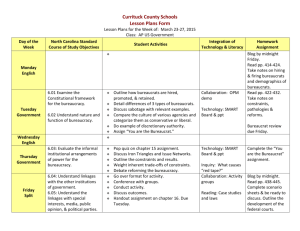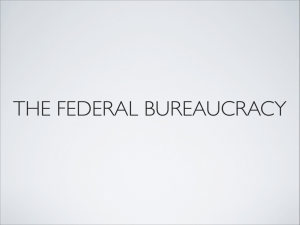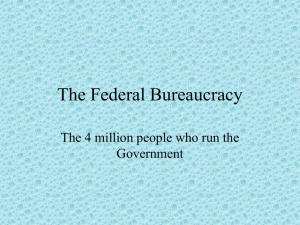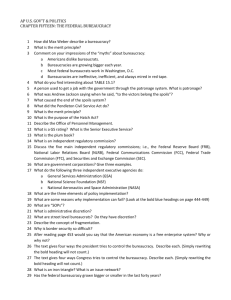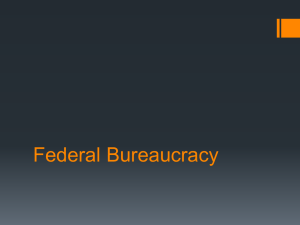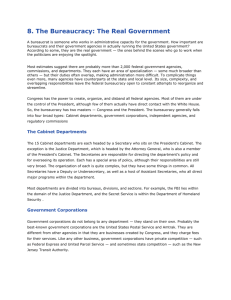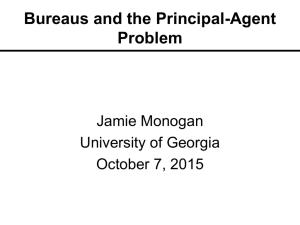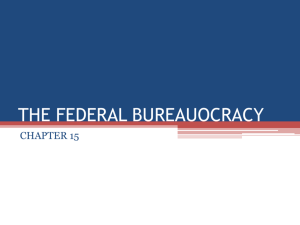The Bureaucracy
advertisement
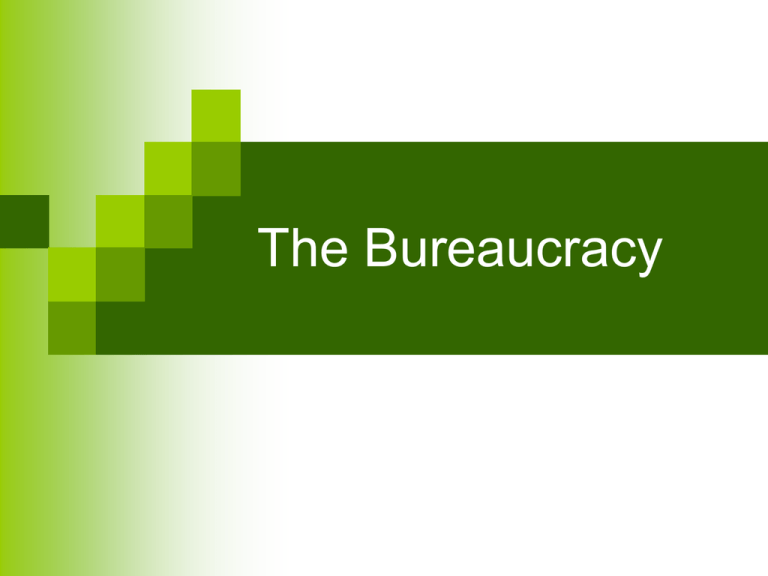
The Bureaucracy Part One: Structure of the American Bureaucracy I. Bureaucracy (General Term): The agencies, departments, commissions, etc. within the executive branch. II. Executive Office of the President: White House Office, OMB, Counsel of Econ. Advisors, National Security Counsel. III. Cabinet: 15 departments + 6 w. Cabinet Rank. IV. Independent agencies: A. Organized much like Cabinet departments, but lack Cabinet status. B. Generally, the decisions of these are beyond presidential control, though commissioners are appointed by the President with Senate consent: C. Examples: NASA, Small Business Administration, FEMA. V. Independent regulatory commissions: A. Created by Congress to regulate important aspects of nation’s economy (CBO). B. Serve long terms, tough to fire, and cannot be strong majority of a particular political party. Important regulatory commissions: Federal Reserve Board Federal Communications Commission Federal Election Commission National Labor Relations Board Securities Exchange Commission Federal Trade Commission VI. Government Corporations: A. Created by Congress to carry out various business operations. B. Examples: Postal Service, Federal Deposit Insurance Corporation, Federal Savings and Loan Insurance Corporation, Tennessee Valley Authority Part Two: Influences on Bureaucratic Behavior I. Recruitment and retention policies A. 90% of bureaucrats are appointed by virtue of some sort of merit system. However, agencies can circumvent the merit system in various ways: 1. Writing job qualifications that only fit one person. 2. Making “temporary appointments” of the desired person, and renewing them yearly. 3. Bringing a person into a lower level job, but giving him/her the duties of the actual job. B. Extremely difficult to fire a civil servant. Elaborate process that must ensure due process (documentation, time). C. Effects of the above: 1. Many bureaucrats have a “loyal” or “agency” point of view. 2. Continuity of agency behavior. 3. Expertise in policies and procedures among many bureaucrats. D. Veterans, women, minorities = attractive hires. II. Personal attributes of bureaucrats: A. Lower and middle-level bureaucrats fairly representative of a broad cross-section of American people on basis of sex, race, religion, etc. B. Upper-level bureaucrats are unrepresentative: mostly middle-aged white males with college degrees from advantaged background. C. Criticisms of personal attributes: 1. Left believes that upper-level bureaucrats defend class privileges which leads to a conservative bias. 2. Right believes that upper-level bureaucrats are trained by liberal faculty at elite colleges - leads to liberal bias. D. Surveys reveal bureaucrats tend to be more liberal than general public. E. Those who work in “activist” agencies (Environmental Protection Agency), tend to be more liberal than those working in “traditional” agencies (Justice, Defense). F. 10% live in D.C. area. G. 30% work in a defense agency. H. Contrary to popular belief, less than 15% work in a welfare agency. I. Most are white-collar workers. III. Legal Constraints: A. Freedom of Information Act (most info needs to be made public). B. Hatch Act: Limits political activities of bureaucrats. Prevents conflict of interest. C. Affirmative action hiring guidelines. D. Environmental impact report requirement of projects. IV. Organizational constraints: A. Sheer size of agencies makes it difficult for bureaucrats to take bold action. B. Red tape inhibits bureaucrats. C. Lack of $ incentives and presence of various disincentives inhibit bureaucrats from taking bold action. Part Three: Controlling the Bureaucracy I. Presidential Influences A. Powers 1. Appointment of top-level. 2. Power to fire top-level. 3. Power to propose reorganization of executive branch. 4. Proposes agency budgets. 5. Appointment of Senior Executive Service personnel. - 7000 senior career officials can be appointed w/out Senate consent. - Greater leeway in firing, transferring, promoting, and rewarding. B. Checks of Presidential Influence: 1. Senate confirmation needed for top personnel. 2. President cannot fire vast majority. 3. Reorganization must go through Congress. 4. Agency budgets must go through Congress. II. Congressional influences: A. Powers: 1. Appropriations of agency budgets. 2. Oversight, investigations, and hearings. 3. Reorganization 4. Appointment confirmation 5. “Sunset laws” that give agencies a limited life and require that they justify their existence. B. Limits on Congressional Influence? 1. Members profit politically from the existence of federal programs within their states/district. 2. Easier for Congress to simply pass broadly worded laws and have experts w/in the bureaucracy fill in holes. 3. Congress has not been able to exercise the legislative veto since 1983. III. Interest group influence: A. Lobbying B. “Revolving door:” many agencies are staffed by people who move back and forth between public and private sectors. Concern is that these people may not regulate carefully the very people who may be their next employers. C. Client groups: some agency-interest group relations are so close that the interest group is said to be a client of the agency. D. Iron Triangles (sub governments): congressional committee, relevant agency, related interest groups. E. Issue networks and policy networks: informal groups of people within both the public and private sectors who have common interests. IV. Media A. Scrutiny of Agency Behavior B. Use of “whistle blowers’ within the bureaucracy. Federal legislation protects them. V. Courts: use of injunctions and writs of mandamus. VI. Privatization, as a means of making the bureaucracy more efficient. VII. Vice President Gore’s 1993 National Performance Review: “reinventing governments” A. Purpose: to bring bureaucracy into the modern age: “from the age of the quill pen to the age of Word Perfect”: To make bureaucracy more accountable and effective B. Elimination of certain subsidies. C. Reducing some programs. D. Elimination of 250,000 federal jobs. E. Reduction of red tape. F. Closure of military bases in post-Cold War era. G. Results: 1. 400 recommendations eliminated. 2. 16,000 pages of regulations (red tape) eliminated 3. Claims of $100 billion in savings.
